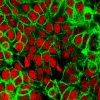
AsianScientist (Sept. 30, 2024) – The landscape of medical science is advancing continuously. New treatment modalities are researched and introduced at a rapid pace, including those for some of the most complex diseases like diffuse large B-cell lymphoma (DLBCL)—a type of aggressive blood cancer. Typically, the standard of care for relapsed or refractory DLBCL involves a series of intensive treatments, including chemotherapy and haematopoietic stem cell transplantation. More recently, through extensive R&D, Chimeric Antigen Receptor (CAR) T-cell therapy has emerged as a promising new treatment option, providing a more effective alternative to those for whom conventional treatments have proven inadequate.
CAR T-cell therapy enlists the body’s own immune cells to target and eliminate cancerous cells. This personalized approach involves modifying a patient’s T-cells in a laboratory to recognize and target attack cancer cells more effectively. Unlike the one-size-fits-all approach of traditional cancer treatments, CAR T-cell therapy is a prime example of precision medicine, presenting a level of specificity that has been shown to improve outcomes in patients with relapsed or refractory large B-cell lymphoma.
CAR T-cell therapy, when used early in the treatment journey, can potentially change the course of DLBCL patients for the better. A pivotal study has shown that patients who receive CAR T-cell therapy as a second-line treatment—rather than waiting for a third-line or later option—often require fewer subsequent interventions. This not only improves the patient’s quality of life but also reduces the overall burden on healthcare systems by streamlining treatment pathways.

“Importantly, therapies that have been shown to enhance overall survival in the second-line setting, such as axicabtagene ciloleucel (axi-cel), should not be delayed until later lines of treatment,” said Professor Mickey Koh, Clinical Director of Oncology and Haematology at St George’s University Hospital, London, United Kingdom. “This timing can be critical for many patients whose clinical condition may unfortunately deteriorate or become too frail, making them unable to receive further intensive therapies needed to achieve a cure.”
As the rollout of CAR T-cell therapies gradually unfolds, it is essential to understand that not allCAR T-cell treatments are created equal. Each therapy has unique characteristics, efficacy rates and safety profiles that can vary substantially based on the patient’s specific type of lymphoma, their overall health and the stage of their disease.
“The correct decision for which CAR T-cell therapy to choose depends on several factors including response rates, toxicity profile and clinical experience with its usage in individual treating centers. In urgent cases where treatment urgency is paramount and where time is of the essence, a product known for its quick turnaround time and reliable manufacturing process would be the preferred choice. Ultimately, clinicians must balance many factors to make an informed decision when choosing the most appropriate CAR T-cell product for their patients,” added Prof Koh.
Having access to more than one CAR T-cell therapy offers flexibility in patient care—helping to mitigate supply issues and providing alternative options if a particular therapy is not suitable for a patient’s condition. This diversity in treatment options ensures that each patient receives the most appropriate care tailored to their specific needs.
Currently, three CAR T-cell therapies—axi-cel, tisagenlecleucel (tisa-cel) and lisocabtagene maraleucel (liso-cel)—have received approval in various countries for the treatment of adult patients with DLBCL. These therapies may be used either in the second and/or third-line setting for adult patients with relapsed or refractory DLBCL depending on their indication approved in the country. The results from these therapies remain promising, with a clinical study on axi-cel showing that patients with DLBCL who received treatment were 2.5 times more likely to be alive at two years without disease progression or the need for additional cancer treatment compared to those receiving the standard of care.
While the promise of CAR T-cell therapy is positive, accessibility remains the crux of the challenge. The complex manufacturing process, high costs and limited number of qualified treatment centers mean that not all eligible patients can easily access this therapy. Many who live in regions with less developed healthcare infrastructure must travel to specialized centers, which can be a hassle in itself.
Despite cost challenges, clinical data has shown that CAR T-cell therapies have led to significantly better response rates and survival outcomes in patients with large B-cell lymphoma—particularly in second-, third-, or later-line settings.
“These findings underscore the transformative potential of CAR T-cell therapy in improving patient outcomes, offering a significant advantage over previously available standard-of-care options,” said Prof Koh.
This article is supported by Gilead and Kite Oncology.
—
Source: Gilead and Kite Oncology ; Image: Unsplash
Disclaimer: This article does not necessarily reflect the views of AsianScientist or its staff.

